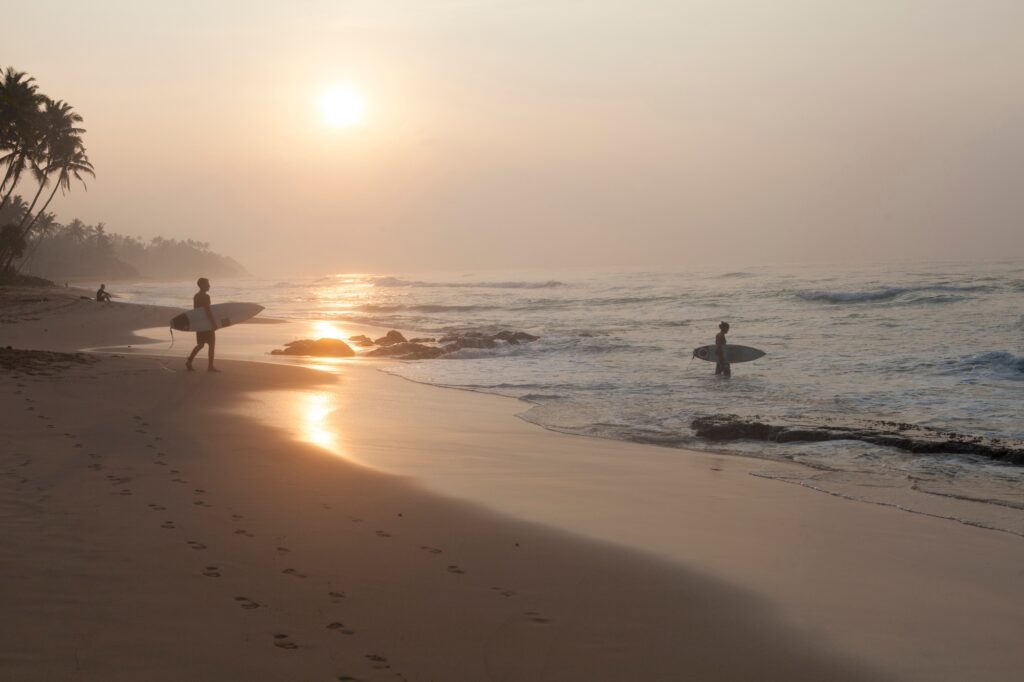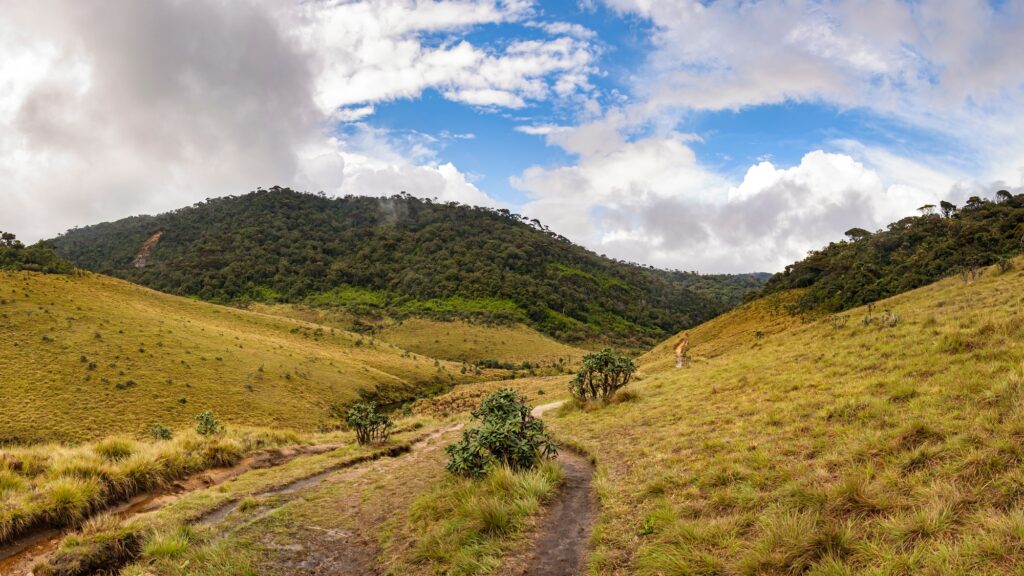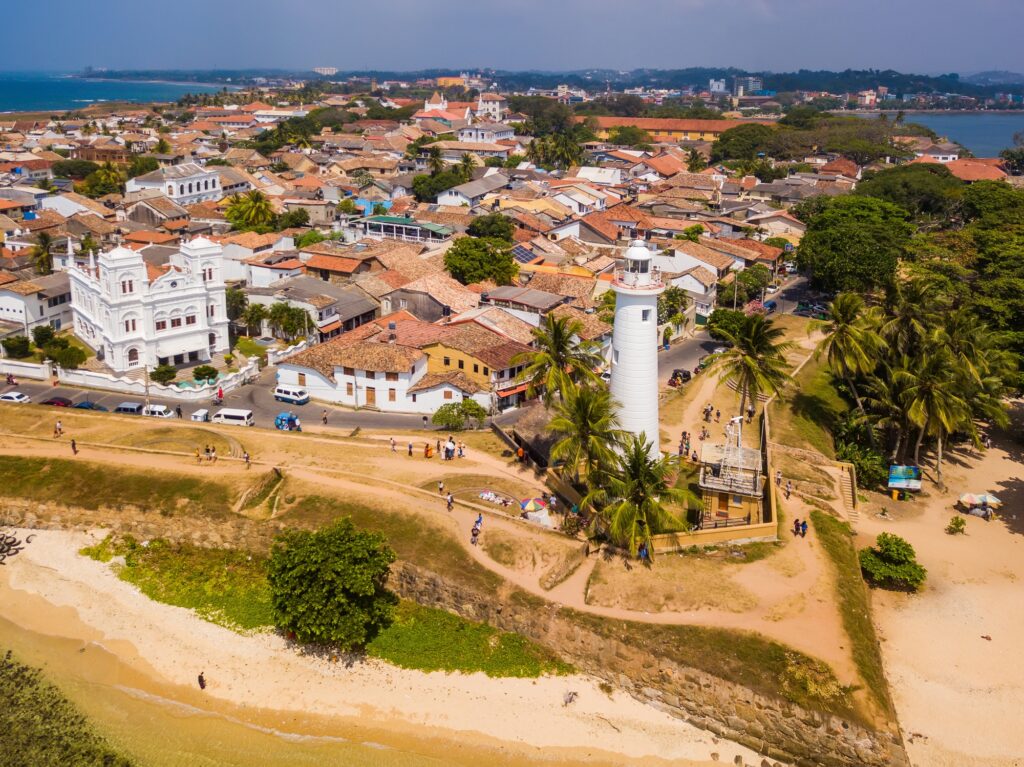Introduction: The Lion Rock Awaits
Located in the central province of Sri Lanka, Sigiriya, commonly known as Lion Rock, is a grand ancient rock fortress that embodies both cultural and historical significance. This UNESCO World Heritage site is recognized not only for its breathtaking views but also for its architectural brilliance, attracting visitors from around the world. The history of Sigiriya Rock dates back to the 5th century AD, when it was established by King Kashyapa as a royal citadel. The site is flanked by lush greenery, offering an alluring contrast to the rugged rock face, which stands at 200 meters high.
As travelers approach the fortress, the magnificent lion’s paws at the entrance serve as a testament to its regal past. The journey to the summit involves a rewarding climb on well-structured staircases and pathways, making it accessible to many, including families, through special considerations for those looking to climb Sigiriya with kids. This ascent provides not only a physical challenge but also an exploration of the vibrant Sigiriya frescoes that adorn the walls, depicting celestial maidens in stunning colors. Various elements of the ancient architecture can be observed, revealing the ingenuity of the builders of this ancient rock fortress in Sri Lanka.
For those seeking things to do in Sigiriya, the experience extends beyond merely climbing the rock. The surrounding area is part of the Sri Lanka Cultural Triangle, replete with temples, archaeological sites, and rich local fauna and flora. Whether you choose to engage in an early morning Sigiriya hike or explore the historical narratives interwoven within the site, Sigiriya promises to captivate every visitor. Each angle offers a distinct Sigiriya view, ensuring an unforgettable experience filled with cultural enlightenment and natural beauty.
Historical Background: The Rise of King Kashyapa
Sigiriya, also known as Lion Rock, stands as a testament to the ingenuity and artistry of ancient Sri Lanka. In the 5th century AD, King Kashyapa ascended to the throne, driven by a tumultuous past and a desire for power. The historical context surrounding his reign is essential to understanding the significance of this ancient rock fortress. Kashyapa, motivated by the fear of retribution from his brother, fled to Sigiriya and chose this formidable rock as the site for his royal palace. It was during this time that the construction of the Sigiriya fortress commenced, establishing it as one of the redefining symbols of power and protection in the region.
The engineering marvel of climbing Sigiriya Rock was a feat that combined both innovation and artistic expression. This took the form of intricate frescoes that adorned the walls, depicting celestial maidens, which remain among the most admired sigiriya frescoes today. The rock’s strategic location provided a vantage point that was difficult for potential intruders to breach, thus securing the royal sanctuary that King Kashyapa envisioned. With its elaborate gardens, water features, and impressive structures, the site transformed into a grand royal residence.
However, the reign of King Kashyapa was fraught with challenges, eventually leading to his downfall. After a brief period of flourishing artistic and cultural development, the royal fortress gradually lost its significance following King Kashyapa’s death. The site underwent a transformation from a palace into a Buddhist monastery, which further emphasizes its multifaceted historical context. Nowadays, Sigiriya is recognized as one of the UNESCO sites in Sri Lanka, along with its standing as a vital part of the Sri Lanka cultural triangle. The history of Sigiriya Rock is an integral aspect of understanding this majestic monument that continues to attract tourists, who seek to explore the landscape, climb Sigiriya with kids, or take an early morning Sigiriya hike for breathtaking views.
Architectural Highlights: A Marvel of Ancient Engineering
The architectural grandeur of Sigiriya, often referred to as the Lion Rock, is a testament to the sophisticated engineering capabilities of its creators during the reign of King Kashyapa in the 5th century AD. This ancient rock fortress is not merely a fortress but a manifestation of artistry and ingenuity, designed to impress and to protect. As one ascends the rock, they will encounter a series of remarkable structures, each showcasing the intricate craftsmanship of the period.
The famed Mirror Wall, originally covered in a shiny plaster that reflected the images around it, is an exquisite creation. It is not just a wall; it served as a canvas for poets and travelers, who left their inscriptions that can still be discovered today. The wall captures the essence of the past, connecting visitors with the thoughts and feelings of those who once stood here. The delicate nature of this structure is emblematic of the meticulous care given to every aspect of the Sigiriya fortress.
Another highlight is the stunning Sigiriya frescoes, which depict celestial maidens in a dance that symbolizes the beauty of nature and artistry from the time of King Kashyapa. These vibrant murals showcase the skill of ancient artists, using natural pigments to breathe life into rock surfaces. The freshness of these frescoes lies in their intricate details and the evocation of ethereal beauty, causing awe among visitors exploring the fortress.
Furthermore, the magnificent water gardens of Sigiriya are a marvel of ancient hydraulic engineering, featuring a network of ponds, fountains, and gardens that exemplify the advanced water management systems of the time. Securely situated within the landscape, they not only served aesthetic purposes but also showcased the intelligence of design, contributing to the vibrant ecosystem surrounding the ancient rock fortress. The experience of climbing Sigiriya Rock is enhanced through these architectural wonders, ultimately making Sigiriya a captivating destination within the UNESCO sites in Sri Lanka.
The Climb: A Journey to the Sky
Climbing Sigiriya, often referred to as Lion Rock, is not merely an exercise in physical endurance, but rather an experience steeped in history and natural beauty. This ancient rock fortress in Sri Lanka, recognized as one of the notable UNESCO sites in Sri Lanka, presents an exhilarating challenge for all who dare to reach its summit. The journey towards the top encompasses approximately 1,200 steps, winding upward through remnants of long-lost civilization.
As you begin your ascent, the initial steps lead you through lush gardens that reflect the meticulous landscape architecture of King Kashyapa, who constructed this fortress during the 5th century. The climate in this region can vary, so preparing for either a warm morning sun or a cool afternoon is essential. Many travelers choose to embark on an early morning Sigiriya hike to appreciate the serenity of the surroundings, enhance their climbing experience, and dodge the heavier foot traffic that tends to accumulate later in the day.
As you continue to climb Sigiriya Rock, you will encounter several attractions, including the famous Sigiriya frescoes that adorn the rock face. These vibrant paintings are a testament to the artistic prowess of Sri Lanka’s ancient inhabitants and provide insight into the cultural significance of this site. Upon reaching the summit, climbers are rewarded not only with a sense of accomplishment but also with magnificent panoramic views of the surrounding landscape, showcasing what has been referred to as the Sri Lanka cultural triangle.
The view from the top of Sigiriya encompasses the remnants of the fortress itself, looking down upon the lush greenery and intricate water gardens below. This breathtaking perspective serves to remind visitors of the once-great civilization that thrived in this area. Ultimately, the climb to Sigiriya entails both physical exertion and an exploration of the rich history of this ancient rock fortress in Sri Lanka, making it an unforgettable experience for adventurers and history enthusiasts alike.
Legends and Facts: Tales of Ancient Wisdom
The history of Sigiriya Rock, also known as Lion Rock Sigiriya, is steeped in captivating legends that weave together the tale of its creation and the splendor of its structures. Central to this narrative is King Kashyapa, who transformed this colossal rock into an extraordinary fortress and royal palace in the 5th century AD. According to historical accounts, Kashyapa seized the throne from his father, which led him to construct the ancient rock fortress as a means of protecting himself from his brother, Mogallana, who sought to claim the kingdom. This dramatic struggle for power forms the backbone of the myths surrounding Sigiriya.
King Kashyapa’s architectural vision is reflected in the impressive engineering of the site. The fortress is renowned for its innovative water management systems, which include an extensive network of reservoirs, and ponds designed to harvest rainwater and serve the needs of its inhabitants. Visitors marvel at the clever integration of these systems, showcasing the advanced engineering skills of the time. The breathtaking Sigiriya frescoes that adorn the boulder walls depict celestial maidens and add to the cultural significance of this UNESCO site in Sri Lanka.
As explorers embark on their journey to climb Sigiriya Rock, they are graced with sweeping views that reveal the historic grandeur of the surrounding landscape. The strategic layout of the Sigiriya fortress, with its defensive walls, moats, and elaborate gardens, indicates a thorough understanding of aesthetics and security. Those planning a visit will discover a rich tapestry of stories hidden within the remnants of this ancient site, enriching their appreciation and exploration of things to do in Sigiriya. From engaging with the history of Sigiriya Rock to experiencing the natural beauty of the Sri Lanka Cultural Triangle, the legends of Sigiriya serve as a poignant reminder of the ancient wisdom that continues to resonate today.
Travel Tips: Making the Most of Your Visit
When planning a trip to Sigiriya, also known as Lion Rock Sigiriya, it is essential to consider several factors to enhance your visit to this iconic site. As one of the UNESCO sites in Sri Lanka, Sigiriya boasts not only breathtaking views but a rich tapestry of history that dates back to King Kashyapa. To make the most of your time at this ancient rock fortress, understanding the best times to climb is crucial. Early morning hikes are highly recommended, as the temperatures are cooler, and the light enhances the spectacular view of Sigiriya. Additionally, visiting during the shoulder seasons may provide fewer crowds and a more serene atmosphere.
Essential items to bring are equally important for an enjoyable experience. Comfortable, sturdy footwear is a must, as you will be climbing uneven rock surfaces and navigating steep steps on your ascent. It is advisable to bring plenty of water to stay hydrated, especially during warmer months. Sunscreen, hats, and insect repellent should also accompany your gear to offer protection from the sun and bugs during your climb.
Moreover, fitness levels should be taken into account. The climb to the summit of Sigiriya Rock can be challenging, and maintaining a moderate level of physical fitness is recommended. Families looking to climb Sigiriya with kids might consider scheduling breaks along the path to allow everyone to enjoy both the hike and the stunning Sigiriya frescoes that adorn the rock walls. The journey offers not only a thorough workout but also a chance to delve into the history of Sigiriya Rock and appreciate its artistic heritage.
For those who want to explore more, consider combining your visit with other attractions in the Sri Lanka cultural triangle. This area includes sites like Polonnaruwa and Anuradhapura, which further enrich your understanding of Sri Lanka’s cultural history. By considering these travel tips, you are sure to have a memorable visit to Sigiriya, one of the most remarkable places to include in your Sri Lanka travel guide.
Experiencing Sigiriya: Engaging with Culture and Nature
Visiting Sigiriya in Sri Lanka is an immersive experience that seamlessly blends culture, history, and nature. The majestic Lion Rock, rising dramatically from the surrounding landscape, is not just a geological marvel, but also a profound testament to the ingenuity of its creator, King Kashyapa. As you approach this ancient rock fortress, known for its distinctive shape, the energy of the site becomes palpable. The vivid greens and earthy tones of the surrounding jungle set a stunning backdrop, enhancing the beauty of this UNESCO site.
The multiple pathways leading to the summit offer visitors a diverse choice of experiences. Opting for an early morning Sigiriya hike presents a tranquil atmosphere filled with the sounds of nature awakening. The gentle rustle of leaves, the chirping of birds, and the fragrant blossoms create an engaging sensory experience, making the climb to Sigiriya rock a worthwhile endeavor for all. As you ascend, you will come across remarkable elements such as the Sigiriya frescoes, which have stood the test of time, showcasing the artistic prowess of the past. These murals, depicting celestial maidens, infuse the climb with historical depth and cultural significance.
As you ascend higher, the views become increasingly spectacular, as the vast expanse of the Cultural Triangle of Sri Lanka unfolds before your eyes. The cultural richness of this area is highlighted by the intricate gardens and water systems that reflect ancient urban planning. The experience is not just physical; it’s a journey through time, connecting you to the history of Sigiriya rock, the legends of King Kashyapa, and the sophisticated society that once thrived here. Engaging with such a rich tapestry of cultural history and natural beauty invigorates the spirit and leaves a lasting impression on visitors.
Concluding Thoughts: More Than Just a Visit
Visiting Sigiriya, often referred to as Lion Rock, transcends the typical tourist experience, offering a profound glimpse into the rich tapestry of Sri Lankan history and culture. As one gazes upon the ancient rock fortress, its majestic presence commands respect and admiration. The history of Sigiriya Rock, associated with King Kashyapa, holds tales of power, intrigue, and artistry that continue to resonate with visitors. This UNESCO site in Sri Lanka is not just a monument, but a testament to the ingenuity of the ancient Sri Lankan civilization.
The climb up Sigiriya Rock presents an opportunity for personal reflection. Each step brings adventurers closer to the captivating Sigiriya frescoes, depicting celestial maidens who once adorned the walls of this magnificent fortress. These vibrant murals, preserved through the centuries, invite exploration of the artistry and cultural significance of the era. The sweeping Sigiriya view from the top is truly spectacular, offering panoramic vistas of the surrounding landscapes, which are as enchanting as the historical narratives that underpin this site. The experience is enriched further by the lush greenery characteristic of the Sri Lanka Cultural Triangle.
Moreover, Sigiriya serves as a central hub for those interested in exploring other attractions within the Cultural Triangle, making it a prime spot within the itinerary of things to do in Sigiriya. Families can also embark on adventurous climbs, including early morning Sigiriya hikes that cater to those wishing to witness the sunrise. Each visit to this ancient rock fortress will undoubtedly evoke a sense of wonder and respect for the past, encouraging travelers to appreciate the historical significance beyond its aesthetic appeal. Thus, Sigiriya is not merely a place to visit; it is an adventure into a world where history and nature meld seamlessly, inviting one to contemplate the legacy left behind by its creators.
Getting to Sigiriya
Reaching Sigiriya, an ancient rock fortress nestled in the heart of Sri Lanka, is relatively straightforward, thanks to its strategic location within the Sri Lanka Cultural Triangle. The nearest major city is Dambulla, approximately 15 kilometers away, which serves as the primary gateway for most travelers. From Dambulla, several transportation options are available to access the Lion Rock Sigiriya.
For those traveling from Colombo, the capital city of Sri Lanka, the journey to Sigiriya requires a bit more planning. The distance from Colombo to Sigiriya is around 170 kilometers, and the most convenient way to travel is by car or bus. The Sri Lanka Railways also offers Train services are available to Habarana, which is the nearest railway station to Sigiriya, where a taxi or local bus can then be utilized to complete the remaining stretch to Sigiriya.
Once in Sigiriya, a variety of accommodations exist to cater to different budgets and preferences. Ranging from luxury hotels with stunning views of Sigiriya Rock to modest guesthouses that offer a more local experience, options abound for all travelers. Many establishments provide conveniences such as guided tours to the Sigiriya fortress and easy access to local attractions.
For visitors looking to climb Sigiriya Rock, it is essential to begin this ascent early in the morning to avoid the heat and enjoy breathtaking views. The Sigiriya frescoes and ancient ruins serve as tantalizing rewards for those who undertake the hike. Additionally, those traveling with kids should consider arranging a guided tour, which can offer valuable insights into the rich history of Sigiriya and make the climb more engaging for younger visitors.
Ultimately, Sigiriya is not just a destination; it is an experience that encapsulates the cultural heritage of Sri Lanka. With its well-connected transport links and myriad accommodation choices, this UNESCO site stands as a compelling point of interest for all visitors to Sri Lanka.





